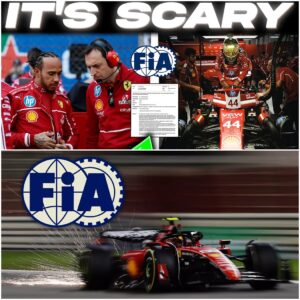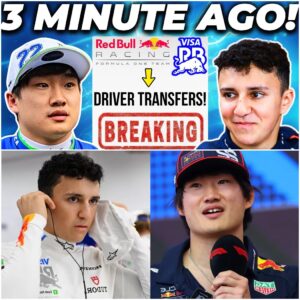The Formula 1 World Championship is meant to be a cathedral of pure, unadulterated meritocracy. It is where the most talented drivers, backed by the best engineers, compete on a level playing field, where the difference between glory and defeat is measured in millimeters, tenths of a second, and sheer competitive nerve. Yet, as the title fight hurtles toward its final, dramatic conclusion, one of the leading title contenders, McLaren’s Oscar Piastri, faces a devastating, non-sporting threat: a piece of administrative paper.
Can you imagine losing the greatest prize in motorsport, not because of a mechanical failure, a strategic blunder, or a superior rival, but because a rule forces you to sit on the sidelines and watch someone else drive your car? This is the shocking reality confronting Piastri. At the worst possible moment—the very race that is poised to define the World Championship—he is obliged to surrender crucial preparation time, time that his rivals will fully utilize, all thanks to an International Automobile Federation (FIA) regulation that, while noble in theory, is proving to be ruinous in execution.

The Administrative Albatross: A Rule Designed to Help, Now Destroys
The regulation in question dictates that all teams must give two Free Practice 1 (FP1) sessions per car to a rookie driver—defined as someone who has participated in no more than two Grand Prix. The spirit of this mandate is, on the surface, entirely commendable: it aims to open space for new talent, generating vital exposure and data to evaluate future signings. It is a pathway for the next generation of F1 stars.
However, the path to sporting integrity is paved with good intentions that often collide violently with the fierce reality of a title fight. Lando Norris, Piastri’s teammate, has already fulfilled McLaren’s obligation on his side of the garage, handing his car over to Alex Dunn and Pato O’Ward in earlier events. Piastri, however, was immersed in a ferocious campaign of collecting key championship points during those viable periods. McLaren, logically prioritizing his title bid, postponed his two mandatory rookie sessions.
Now, with the racing season down to a handful of Grand Prix, the clock has run out. McLaren is cornered, legally obliged to remove their primary title challenger from the car for at least one FP1, and that session, ironically and agonizingly, may fall on the race that defines the entire World Championship.
The Calendar Conundrum: Too Much Risk, Too Little Track
The need to give up a key FP1 session in Piastri’s car is not a simple administrative formality; it is a time bomb that has fundamentally conditioned the technical planning of the final rounds of the championship.
McLaren’s strategists found themselves staring at a schedule that offered no easy outs. Circuits utilizing the Sprint format were immediately ruled out. In the Sprint format, there is only one FP1 session before qualifying for the short race. Giving up that solitary test would be considered technical suicide. It is the only opportunity for the primary driver to validate the crucial baseline setup before the configuration is locked for the rest of the weekend. To miss it is not just a disadvantage—it is a surrender.
With certain earlier Grand Prix already used by Norris, only two viable alternatives remained: the high-risk street circuit and the championship finale venue. And neither is remotely ideal.

The Street Circuit Nightmare: A Roll of the Dice
The nocturnal street circuit represents an almost perfect storm of unpredictability. It is a new, urban track with extreme, freezing temperatures that dramatically affect the tires’ operating window, grip, and the rate of asphalt evolution. It is, quite simply, one of the most unpredictable scenarios on the calendar.
Introducing a rookie driver to Piastri’s car in this potential chaos would be an act of genuine technical recklessness. It would be like “rolling a dice hoping that exactly the one you need comes up.” The learning curve on the street circuit is steep, the walls are incredibly close, and any mistake can result in a red flag, structural damage, and a car that needs to be rebuilt against the clock. The risk is not merely Piastri losing his filming time; it is the terrifying possibility that a rookie crash forces him to miss the crucial FP2 session entirely, due to repairs. This is not hypothetical; it is a real possibility that McLaren cannot ignore.
The Crushing Irony of the Championship Finale
For all these reasons, all roads lead to the Yas Marina circuit in Abu Dhabi. It is one of the safest on the calendar, boasting large escape areas and more stable conditions, making it the least bad option to comply with this administrative obligation. But here comes the most painful irony: this Grand Prix is most likely where the championship will be decided.
If Oscar Piastri enters that final race with a minimal points difference over rivals like Max Verstappen, George Russell, or Lando Norris, he will be the only title contender to start the weekend at a concrete, structural disadvantage.
This is not a symbolic blow to morale; this is a loss of real, tangible data. We are talking about telemetry of track sensations, how the car interacts with that specific asphalt, and the initial check of the mechanical setup. All this foundational information is built from FP1, and Piastri simply won’t have it. While the race conditions are at night, the daytime FP1 remains essential for initial checks, validating simulator data, and beginning to calibrate the behavior of the tires. It is the only time drivers can experiment freely with setups without the pressure of the stopwatch. Getting to FP2 and FP3—which are much more rigid, closed sessions—without that prior filming is like running a marathon without warming up.
The Microscopic Margins of Technical Sabotage
The technical cost of losing a practice session in Formula 1 cannot be underestimated. The margins between glory and failure are microscopic. Half a degree of temperature in the brakes, or a motor map that isn’t validated in time—the difference between having that data and not having it can cost you a pole position.
The domino effect from this one session loss is devastating and direct:
Lost Calibration: Piastri cannot fine-tune the critical aerodynamic balance and mechanical response that the long straights and low-speed corners of the final circuit demand. He must wait until FP2.
Qualifying Risk: A lack of confidence in the unvalidated setup could lead to him not finding the limit in qualifying, resulting in a poor grid position.
Race Collapse: A bad start puts him in traffic, traffic degrades tires, and a strategy validated without sufficient time collapses—all traceable to the initial deficit.
McLaren has opted for a damage mitigation strategy, likely selecting Alex Dunn—a technically competent and disciplined pilot—to take the seat. But even with Dunn, the risk remains. There is no rookie without a margin for error, and there is no FP1 that is not critical.

The Ethical Quagmire: Youth Quotas vs. Sporting Integrity
This situation elevates the sporting conflict to a profound ethical dilemma. Formula 1 prides itself on being built on extreme meritocracy, where only the most consistent survive and win. Yet, the regulatory system introduces a structural distortion that compromises that core principle.
The rookie driver rule, as currently designed, does not adapt to the real competitive context; it offers no exceptions and no compensation mechanisms. The most serious consequence is that it has the power to alter the final result of the championship itself.
To what extent should a regulation that requires meeting youth participation quotas take priority over sporting integrity? Is it fair that a driver in the middle of fighting for the most prestigious title in motorsport has to sacrifice his preparation for an obligation that could have been resolved earlier in the racing schedule? What is the point of promoting the training of future talents if, in the process, you are actively sabotaging the present of one of the brightest young stars the category already possesses?
Piastri’s rivals—Verstappen, Russell, Norris—will all enjoy their three full, uninterrupted sessions, working calmly, adjusting, experimenting, and validating every change. Piastri will not. This regulation pushes him into a position of profound sporting vulnerability created not by any fault in his performance, but by a paper protocol that blindly ignores the competitive drama unfolding on the track.
Oscar Piastri is playing for the world championship. Every point counts, every sector matters. Yet, he could be the only title contender forced to voluntarily give up a session of preparation on the most important weekend of the year—not because of an accident or a sanction, but by a rule written on paper. A rule intended to develop young talent is, in this unique and brutal instance, condemning the most successful young driver of the moment.
If Piastri loses the championship by a minimal margin—if his qualifying is compromised or his race pace is sub-optimal because he could not calibrate the ideal balance—all of it can be traced back to the mandatory loss of an FP1. That session should never have fallen on a driver fighting for the pinnacle of world motorsport. The regulation will have ceased to be an instrument of order and has instead become a factor of catastrophic distortion. The question for the FIA, the teams, and the fans is simple: is this the legacy Formula 1 wants to leave on its championship season?





